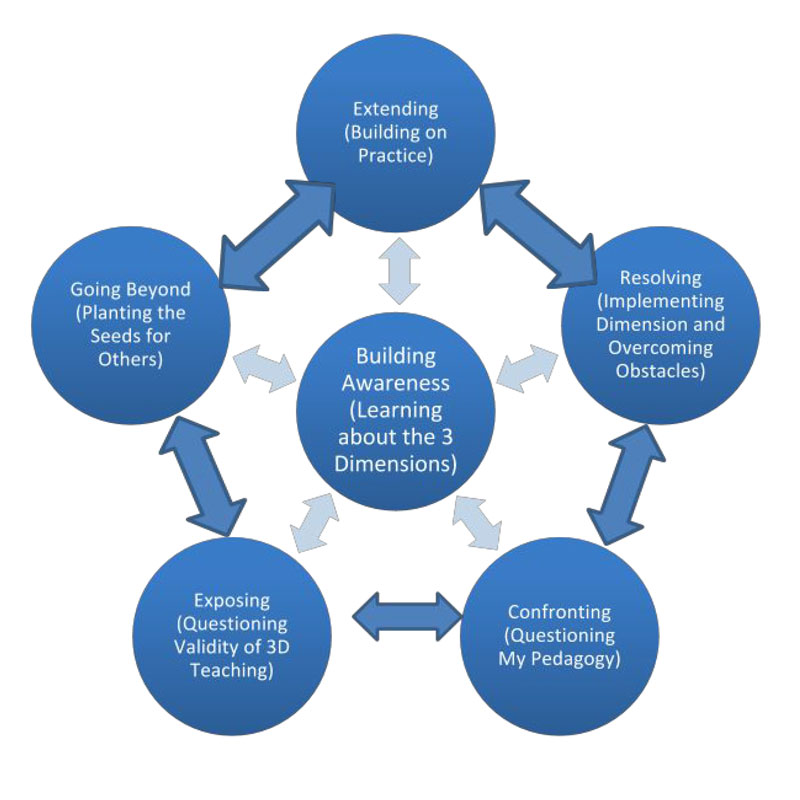What Does Conceptual Change in 3D Teaching Look Like?
The steps are listed in a linear format, but the change to a 3D teacher can happen simultaneously and in repeating cycles. Content is usually the first dimension for teachers. The second that is integrated is Practices. Crosscutting Concepts are the final dimension of 3D teaching. Trainers can help you identify where you are with the following tool:
 Building Awareness (Learning about the 3-Dimensions)
Building Awareness (Learning about the 3-Dimensions)
- 1D: Content Mastery
- 2D: Understanding Practices through reading, experience, and discussion
- 3D: Understanding Crosscutting Concepts through reading, experience, and discussion
 Exposing (Questioning the Validity of 3D Teaching)
Exposing (Questioning the Validity of 3D Teaching)
- 1D: Does 3D teaching fit with my content? Do I value 3D teaching pedagogy?
- 2D: How do I implement Practices within the time constraints of my grade level? Do I value Practices in the classroom?
- 3D: What is appropriate for my students’ use of Crosscutting Concepts? Do I value Crosscutting Concepts in the classroom?
 Confronting (Questioning My Pedagogy)
Confronting (Questioning My Pedagogy)
- 1D: Does my current method of content delivery suffice? Are students doing science or listening to science? Am I comfortable enough with my content knowledge to engage 3D teaching? Where are my roadblocks for moving beyond 1D teaching?
- 2D: How do Practices support students doing science? What life skills do Practices support? Do I value Practices? Are experiments in my classroom authentic or canned? How much time can I/should I devote to Practices in my classroom?
- 3D: How do Crosscutting Concepts serve as lenses for learning? How will Crosscutting concepts impact content perspectives? How do Crosscutting Concepts span my content area? Do I value Crosscutting Concepts as lenses for learning or lenses for teaching?
 Resolving (Implementing Dimensions and Overcoming Obstacles)
Resolving (Implementing Dimensions and Overcoming Obstacles)
- 1D: Continue teaching content while making a plan to implement Practices. Resolve conflicts and roadblocks for moving beyond 1D teaching.
- 2D: Begin implementation of Practices to support content. Resolve conflicts and roadblocks for implementation of Practices. Question implementation of dimension(s) and adjust. Repeat.
- 3D: Begin implementation of Practices and Crosscutting Concepts to support content. Resolve conflicts and roadblocks for implementation of Crosscutting Concepts. Question implementation of dimension(s) and adjust. Repeat.
 Extending (Building on Practices)
Extending (Building on Practices)
- 2D: Build assessments that reflect content and Practices. Collect feedback from students to extend 2D pedagogy.
- 3D: Build assessments that reflect content, Practices, and Crosscutting concepts. Collect feedback from students to extend 3D pedagogy.
- Extend Practices and Crosscutting Concepts to other subjects.
 Going Beyond (Planting the Seeds for Others)
Going Beyond (Planting the Seeds for Others)
- Share ideas with other professionals in your grade level, building, or district.
- Work toward connecting Common Core and science Practices in your level, building, or district.
- Work toward connecting Crosscutting Concepts to content in your grade level, building, or district in a cross-curricular context.
Download the PowerPoint presentations below to hear about teachers’ experiences with the conceptual change process and 3D teaching and see examples of how teachers and students implemented 3D in the classroom.



